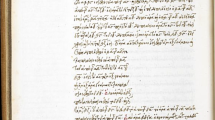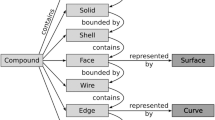Abstract
Guest editors Bojan Tepavčević and Vesna Stojaković introduce the papers in this special issue, Mongeometry. The catalyst for this special issue was the international conference Mongeometrija 2018 held from 6−9th June at the Faculty of Technical Sciences, University of Novi Sad, Novi Sad, Serbia. The focus of this issue is advances in the theory and application of architectural, computational and descriptive geometry.
Similar content being viewed by others
The special issue Mongeometry presents ten papers that were introduced at the Mongeometrija 2018 conference. These papers were independently selected, then further reviewed by experts, before being revised and edited in preparation for publication in the Nexus Network Journal.
Mongeometry is a conference series organized by the Serbian Society for Geometry and Graphics. This event evolved from the Yugoslavian Symposium for Descriptive Geometry. The name of the conference, Mongeometry, coined as a tribute to Gaspard Monge combined with the word Geometry, represents the heritage of this evolution. The conference topic is focused on different aspects of geometry and graphics such as theoretical, applied, engineering, educational and historical.
In 2018, the 6th International conference Mongeometrija was held at the Faculty of Technical Sciences, University of Novi Sad, Novi Sad (Serbia) from 6th to 9th June. This conference, organized by the Department of Architecture, hosted many great researchers with a common interest in the intersections between architecture and geometry. The papers are aimed at research in the fields of architectural theory, architectural geometry, geometrical and construction optimization, digital fabrication and parametric modeling.
The intersection between the theory of architecture in the digital age and architectural geometry is the main issue of the paper “From Cartesian to Topological Geometry: Challenging Flatness in Architecture”. Authors Yannis Zavoleas and Mark Taylor discuss the roots of topological geometry in architecture which can be traced back to late-modernism. They recognize several key developments of that era that challenge Cartesian rationalization and a simplified understanding of form. Some key concepts such as adaptability and smooth transition of form are recognized and investigated in projects of late modernism. These concepts today are central for the topological understanding of form derivation in architecture affected by parametric design and performance based design.
The next two papers in this issue reveal the geometric rules that lie behind certain historic buildings. In the first of these, Maja Petrović, Branko Malešević, Radovan Štulić, Marko Vučić, Đorđe Petrović and Radomir Mijailović provide a mathematical model for the determination of best fitting curve for the floor plan contour of the Dome of San Carlo alle Quatro Fontane. In this paper they provide evidence that multifocal curves (Weberian multi focal/directorial curves) offer the best approximation for the Borromini oval. In the next paper “Geometric proportional schemes of Serbian medieval Raška churches based on Štambuk’s proportional canon” Magdalena Dragović, Aleksandar Čučaković, Marko Pejić and Milesa Srećković present a proportional analyses of Serbian medieval sacred structures (churches of Raška style) by highlighting geometrical principles of relationships found in the triangular proportioning system and ratio between particular dimensions and elements. 3D structural models of the analysed churches were created in a digital BIM environment. A library was created of such elements and enriched by categories of parameters defined by proportions.
The next two papers present geometric constructions which may lead to innovative design outcomes. Marija Obradović discusses the possible ways to tile the triangular face of concave cupolae of the second sort, which can then tile the whole deltahedral lateral surface, forming patterns applicable in architectural design. The author examines the interesting idea to select tilings with triangles and hexagons that produce D3 symmetric arrangements, in order to select the most suitable design for fabrication and assembly. The paper concludes with tiling solutions which can be applied in the design of cupolas, roofs and halls. Milena Stavrić and Albert Wiltsche analyze and investigate auxetic structures and their kinematic characteristics. They present research demonstrating how geometric principles of auxetic structures can be transferred to a family of new possible forms. The approach presented is purely geometrical, demonstrating that a generation of such complex kinematic structures can be done without advanced computer simulations.
Two papers research architectural geometry in construction optimization. In the paper “Geometry and Construction Optimization”, the authors Zlata Tošić, Sonja Krasić, Naomi Ando, and Miloš Milić describe how contemporary technology and optimization methods can help in the process of optimization and digital fabrication. The paper shows the optimization method by using the example of St. Joseph the Craftsman church in Mexico designed by architect Felix Candela. The main value of the paper is that the same workflow can be applied to new designed hyperbolic paraboloids, as well as other complex geometry. The other of these papers “Parametric Design of Masonry Vaults Based on Structural Affinity”, by Dimitrije Nikolić, Vesna Stojaković and Radovan Štulić, presents the concept of affine vaults whose constituent parts are mutually affine cylindrical vaults. By merging structural affinity with thrust line theory, the method supports the design of a variety of complex affine vaults, as well as the automated calculation and graphical representation.
In the paper “Higher-Order Ruled Surfaces and their Possible Use in Architectural Design” higher-order ruled surfaces are analyzed and processed, from the aspect of their application in architecture and design. Authors Vladan Nikolić, Olivera Nikolić, Jasmina Tamburić, Sanja Spasić Đorđević and Sanja Janković focus their research on applying the characteristic segments and cuttings of higher-order ruled surfaces in the design of architectural objects, as well as the possibilities of their multiplication and combining into more complex spatial structures. In the next paper “Kerf Bending Strategy for Thick Planar Sheet Materials”, Dejan Mitov, Bojan Tepavčević, Vesna Stojaković and Ivana Bajšanski propose a cost-efficient design-to-fabrication approach to form planar sheet materials, such as wood based or gypsum boards, which are widely used for interior wall finishing. The proposed fabrication method is based on converting a double surface into a set of developable strips, bent in the direction of kerfs of various depth and size that follow rulings of the surface.
Finally in this special issue, Ioanna Symeonidou presents the results of a parametric design workshop held at the Aristotle University of Thessaloniki and discusses an applied educational methodology for teaching algorithmic design in architecture with a focus on biomorphic forms. The author identifies general guidelines based on examples of good practice but also potential risks that arise from the use of digital design tools without critical thinking.
Author information
Authors and Affiliations
Corresponding author
Additional information
Publisher's Note
Springer Nature remains neutral with regard to jurisdictional claims in published maps and institutional affiliations.
About this article
Cite this article
Tepavčević, B., Stojaković, V. Mongeometry: From Descriptive to Computational Geometry in Architecture. Nexus Netw J 21, 1–3 (2019). https://doi.org/10.1007/s00004-019-00430-x
Published:
Issue Date:
DOI: https://doi.org/10.1007/s00004-019-00430-x




